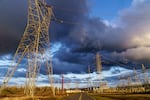The Bonneville Power Administration, which owns more than 75% of the Pacific Northwest’s high-voltage transmission lines, proposed more than a dozen new projects this week aimed at expanding the power grid.
BPA’s proposals are intended to alleviate pressure on a grid facing rapidly increasing demands from the shift to renewable power, the electrification of cars and appliances, and the rise of technology companies’ data centers that use massive amounts of electricity.

The Bonneville Power Administration Troutdale substation, right, and transmission towers, in Troutdale, Oregon, March 6, 2023.
Kristyna Wentz-Graff / OPB
The proposed 13 projects include additional equipment at substations, strengthening existing power lines and constructing new substations that would help meet electricity demand and improve the network’s reliability across Oregon and Washington, BPA Senior Spokesperson Doug Johnson said.
“All of this is to stay out ahead of our customers' needs and ensure again that transmission network can handle all of the electricity traffic that needs to occur to light up data centers, homes, other businesses, all of the things that we use electricity for in the Northwest,” he said.
The estimated price tag: about $3 billion. It comes a year after BPA proposed 10 other projects. Combined, they could cost about $5 billion for 23 proposed projects.
“These are in the early stages of development but go a long way toward meeting the needs of our customers which include investor owned utilities in Oregon, Washington and throughout the region to ensure that they have the energy they need and it can get across our transmission system to serve the growing energy needs that they have,” he said.
Expanding the transmission grid is also necessary for the region to meet its clean energy goals.
Oregon’s House Bill 2021 requires utilities, like BPA customer Portland General Electric, to have net-neutral carbon emissions by 2040. That means utilities need to increase the renewable energy portfolios and invest in more solar and wind energy as well as other renewable technologies that emerge. In Washington, the state is committed to reaching greenhouse gas emission-free electricity by 2045.
Nicole Hughes, executive director of the nonprofit Renewable Northwest, called BPA’s new investments “exciting.” Her organization, which advocates for renewable energy policies, had previously called on BPA to take the lead in improving the Northwest’s power grid.
“These investments will help bring much needed clean energy to customers throughout the region,” Hughes said in a statement. “We are eager to work with Bonneville to see these projects completed.”
But Johnson said the proposed lines and expansions are not all focused on increasing renewable energy projects. Some of the proposals could be powered by fossil fuels, like natural gas.
“Renewables are certainly a large part, but it’s also to ensure that our transmission network can get energy from one point to another,” he said. Responding to increased electricity demand “is a huge part of this. You’ve got companies relocating to the Northwest. There are a lot of data centers in the Portland Metropolitan area in Central Oregon and other parts of the Northwest that need service.”
The proposed projects emerged from a 2023 study that focused on energy needs created by new requests to use BPA’s transmission lines. Johnson said the federal entity received about 16,000 megawatts of service requested needs.
BPA could add about 10,000 megawatts with the 13 transmission upgrades it has proposed.
On average, he said it takes about 1,000 megawatts per minute to power the city of Seattle.
For now, Johnson said these projects are in the early stages and could change as each goes through an environmental review. The smaller upgrades could happen in the next couple of years, while larger construction could take between seven to 10 years.
BPA also said it will spend more than $500 million for grid upgrades to help restore and preserve some of its more than 15,000 miles of existing lines, substations and other electrical equipment.
“We’ve been building transmission in the Northwest since the 1930,” he said. “So a lot of these facilities are 80 years old, 70 years old, 60 years old. They need to be rebuilt — at some point the poles go bad.”
